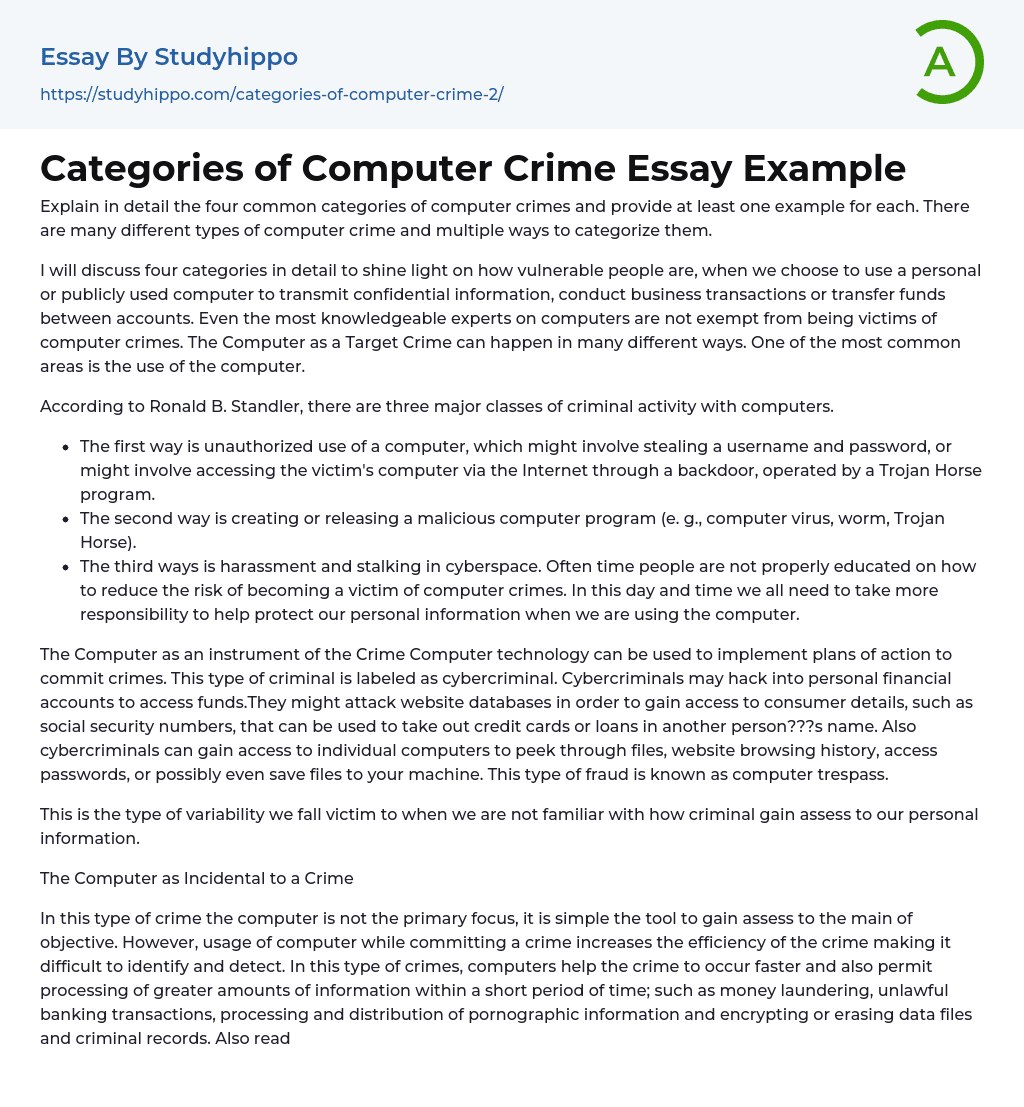Within this text, we aim to elucidate the four primary classifications of computer crimes and furnish an exemplification for each respective category.
There are various types of computer crime and classification methods. This discussion will highlight four categories to show the risks associated with using personal or public computers for tasks like transmitting confidential information, conducting business transactions, or transferring funds. Even experienced computer users can fall victim to computer crimes. Ronald B. stresses that computers are a common platform for criminal activity.
Standler categorizes criminal activity involving computers into three main groups. The first category involves unauthorized use, such as stealing login credentials or accessing a victim's computer through a Trojan Horse program. The second category includes creating and releasing malicious programs like viruses, worms, or Trojan Horses. The third category is harassment and stalking in
...cyberspace.
Standler stresses the importance of educating people to reduce the risk of becoming victims of computer crimes. In today's world, it is crucial for everyone to take responsibility for protecting personal information when using computers. Computers can be used by cybercriminals to commit various crimes.
Cybercriminals may hack into personal financial accounts or target website databases to obtain consumer details, including social security numbers, for fraudulent purposes. They can also access individual computers to view files, browsing history, passwords, or save files without permission. This act is known as computer trespass or fraud.
When we are unaware of how criminals gain access to our personal information, we become vulnerable to these types of criminal activities.
The Use of Computers in Crime
In this type of criminal activity, the computer serves as a tool rather than the main focus. However, incorporating computers
into the commission of a crime increases efficiency and makes detection and identification more challenging. Computers facilitate faster occurrence of crimes and enable the processing of larger amounts of information in a shorter period of time. Examples include money laundering, unlawful banking transactions, distribution of pornographic material, and manipulation or deletion of data files and criminal records. For more information, see the description of computer.
Crimes Driven by Computer Availability
This category of crime is committed simply because computers are accessible. As technology advances, cybercriminals are provided with more tools to carry out their activities.The illegal activities include software piracy, copyright infringement of computer programs, production of fake computer equipment and peripherals (like modems and hard disks), and the unauthorized sale of genuine computer equipment, peripherals, and programs at significantly lower prices on the black market. While the perpetrators may believe that they are benefiting others by offering cheaper merchandise, they are actually causing harm to the original owners. This is because their sales decline when someone steals and duplicates their work for profit.
The present focus is on determining the category of computer crimes that poses the greatest overall threat. In my viewpoint, the most significant threat is computer incidental crime. These crimes occur due to the mere presence of a computer and the perpetrator's knowledge to carry out the task. Such crimes have the ability to impact both our personal and professional lives as more and more information is being processed through computer systems in today's world. One concrete example is money laundering, where individuals unlawfully acquire funds that are transferred through computer systems.
Once the criminal gains unauthorized access to the system, they can drain all accessible accounts.
This is something that has the potential to severely impact billion dollar corporations and cause widespread unemployment, leaving individuals without income to support themselves or their families. Therefore, we must exercise caution in determining who to trust with our personal information.
Reference
- http://www.rbs2.com/ccrime.htm
- http://www.selectitschools.com/Articles/tabid/67/EntryId/3/Six-Common-Types-of-Cyber-Crime.aspxhttp://EzineArticles.com/1017158
- Computer File essays
- Desktop Computer essays
- Servers essays
- Camera essays
- Cell Phones essays
- Computer essays
- Ipod essays
- Smartphone essays
- Agreement essays
- Business Law essays
- Common Law essays
- Community Policing essays
- Constitution essays
- Consumer Protection essays
- Contract essays
- Contract Law essays
- Copyright Infringement essays
- Court essays
- Crime essays
- Criminal Law essays
- Employment Law essays
- Family Law essays
- Injustice essays
- Judge essays
- Jury essays
- Justice essays
- Lawsuit essays
- Lawyer essays
- Marijuana Legalization essays
- Ownership essays
- Police essays
- Property essays
- Protection essays
- Security essays
- Tort Law essays
- Treaty essays
- United States Constitution essays
- War on Drugs essays
- Cybercrime essays
- Cloud Computing essays
- Computer Science essays
- Consumer Electronics essays
- Data Analysis essays
- Electronics essays
- engineering essays
- Enterprise Technology essays
- Hardware essays
- Impact of Technology essays
- Information Age essays
- Information Technology essays




